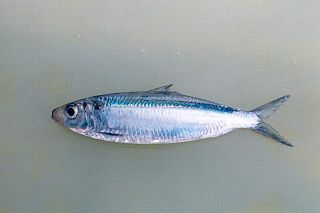 W
WAmblygaster leiogaster, the smoothbelly sardinella, also known as blue sardine, blue sprat, bluebait, is a reef-associated marine species of sardinella in the herring family Clupeidae. It is one of the three species of genus Amblygaster. It is found in the marine waters along Indo-West Pacific regions towards south western Australia. The fish has 13 to 21 dorsal soft rays and 12 to 23 anal soft rays. It grows up to a maximum length of 23 cm. The flank is gold in fresh fish but becomes black while preservation. Belly is more rounded and scutes are not prominent. It is rather closely resemble Amblygaster clupeoides, but the latter has very few lower gill rakers than Smoothbelly sardinella. The fish feeds on minute organisms like zooplankton.
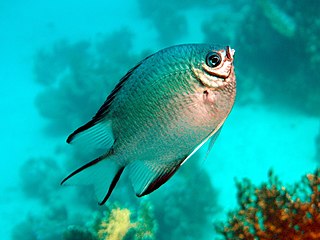 W
WAmblyglyphidodon leucogaster also known as the yellowbelly damselfish is a species of marine fish in the family Pomacentridae, the damselfishes and clownfishes. It's widespread throughout the tropical waters of the Indo-West Pacific, Red Sea included. It's a small size fish that can reach a maximum size of 13 cm length.
 W
WThe Atlantic flyingfish is a flying fish in the family Exocoetidae. It was first described by the French zoologist, Achille Valenciennes in a 22-volume work entitled Histoire naturelle des poissons, which was a collaboration with fellow zoologist Georges Cuvier.
 W
WThe Atlantic tarpon is a ray-finned fish that inhabits coastal waters, estuaries, lagoons, and rivers. It is also known as the silver king. It is found in the Atlantic Ocean, typically in tropical and subtropical regions, though it has been reported as far north as Nova Scotia and the Atlantic coast of southern France, and as far south as Argentina. As with all Elopiformes, it spawns at sea. Its diet includes small fish and crustaceans. It has been recorded at up to 2.5 m in length and weighing up to 161 kg (355 lb).
 W
WThe Australian sprat is a sprat fish whose habitat ranges in the waters surrounding Australia including Tasmania. They can grow to 14 cm. Their depth range is from 0 to 50 m. They often enter estuaries.
 W
WChlorurus capistratoides, commonly known as the Indian parrotfish or the pink-margined parrotfish, is a marine ray-finned fish, a parrotfish from the family Scaridae. This species is native to the eastern Indian Ocean and western Pacific Ocean, where it lives in coral reefs. This species occurs in small schools, frequently mixed in with other fish species, these schools forage over corals in clear coastal and inner reefs where there is abundant algal and coral growth. It feeds on filamentous algae.
 W
WThe Dussumier's halfbeak, also known as the slender garfish, lives in reefs and shallow lagoons. It is an Indo-Pacific species which is found from the Seychelles east to the Tuamotu Islands, north to Hong Kong and Okinawa and south to northern Australia. They form schools which are found near the surface of lagoons and seaward reefs. The longest known specimen was 38.0 cm in length. This species was described by Achille Valenciennes in 1847 with the type locality given as the Seychelles. The specific name honours the French voyager and merchant Jean-Jacques Dussumier (1792-1883).
 W
WThe glass knifefish is a weakly electric freshwater fish found across South America. It is marketed as an aquarium fish.
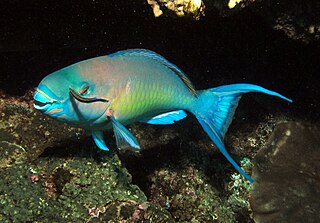 W
WThe ember parrotfish is a species of marine ray-finned fish, a parrotfish, in the family Scaridae. It is native to the Indian and Pacific Oceans. It is also known as the bicolor parrotfish and the redlip parrotfish.
 W
WFodiator acutus, the sharpchin flyingfish, is a species of flying fish in the genus Fodiator endemic to the northeast Pacific Ocean and the eastern Atlantic Ocean.
 W
WGenypterus capensis, commonly known as kingklip, is a species of cusk eel occurring along the Southern African coast from Walvis Bay in Namibia to Algoa Bay in South Africa, and is closely related to Genypterus blacodes from New Zealand. The species grows to a maximum length of 180 cm, a weight of 15.0 kg, and is one of the most popular fish items on South African menus. Despite appearances it is not closely related to the eel family of Anguilliformes.
 W
WHirundichthys rondeletii, the black wing flyingfish, is a species of flying fish from the family Exocoetidae which is found throughout the tropical and subtropical waters of the Atlantic, Pacific and Indian Oceans.
 W
WHoplias aimara, also known as anjumara, traira, trahira, manjuma, anjoemara and wolf fish, is a species of freshwater fish found in the rivers of South America. In Amazonia, the native populations are concerned by high levels of mercury contamination which has been linked to the consumption of contaminated fish. H. aimara is a good bioindicator of such contamination.
 W
WThe Indian oil sardine is a species of ray-finned fish in the genus Sardinella. It is one of the two most important commercial fishes in India. The Indian oil sardine is one of the more regionally limited species of Sardinella and can be found in the northern regions of the Indian Ocean. These fish feed on phytoplankton (diatoms) and zooplankton (copepods).
 W
WKetengus typus, the bigmouth sea-catfish, is the only species in the sea catfish genus Ketengus.
 W
WLabeo horie, the Assuan labeo, is a fish in the genus Labeo which is found in the Blue Nile and the White Nile, including Lake Albert, Lake Kyoga and Lake Turkana.
 W
WLiparis fabricii, commonly known as the gelatinous seasnail or gelatinous snailfish, is a benthopelagic species of snailfish from the Arctic Ocean. It has a tadpole-like body with a maximum length of about 20 cm (7.9 in). It is brown to black in coloration with a distinctive dark peritoneum. It preys on small crustaceans and marine worms. It is not commercially important, though it is a valuable food source for predatory fish and seabirds in the Arctic region.
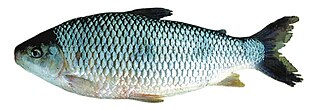 W
WMegaleporinus obtusidens is a South American species of headstander that inhabits the basins of the Paraná River and the Río de la Plata, the Uruguay River, and the São Francisco River. It may be found in the main courses and streams, as well as in lakes and lagoons; it often shelters among stones and aquatic vegetation.
 W
WThe mirrorwing flyingfish is a flying fish of the family Exocoetidae. It was first described by the French zoologist, Achille Valenciennes in a 22-volume work titled Histoire naturelle des poissons, which was a collaboration with Georges Cuvier.
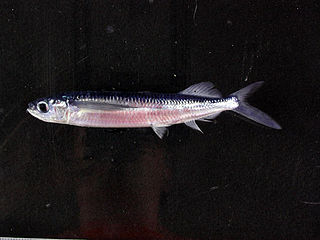 W
WOxyporhamphus micropterus is a species of halfbeak found in the tropical oceans. Some sources elevate the two subspecies to species rankother calssify it in the monotypic genus Oxyporhamphus. This taxon is found in the Indo-Pacific region where it is a pelagic, oceanodromous species. It was described by Achille Valenciennes as Exocoetus micropterus in 1847, with the type locality of King George Sound, Western Australia.
 W
WThe Pacific herring, Clupea pallasii, is a species of the herring family associated with the Pacific Ocean environment of North America and northeast Asia. It is a silvery fish with unspined fins and a deeply forked caudal fin. The distribution is widely along the California coast from Baja California north to Alaska and the Bering Sea; in Asia the distribution is south to Japan. Clupea pallasii is considered a keystone species because of its very high productivity and interactions with many predators and prey. Pacific herring spawn in variable seasons, but often in the early part of the year in intertidal and sub-tidal environments, commonly on eelgrass, seaweed or other submerged vegetation; however, they do not die after spawning, but can breed in successive years. According to government sources, the Pacific herring fishery collapsed in the year 1993, and is slowly recovering to commercial viability in several North American stock areas. The species is named for Peter Simon Pallas, a noted German naturalist and explorer.
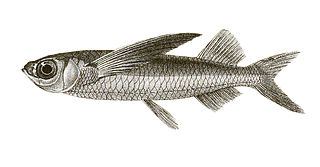 W
WParexocoetus mento; also known as the African sailfin flying fish, Cuvier's flying fish, the yellow belly flying fish or the short-winged flying fish; is a species of flying fish from the family Exocoetidae which is found in the Indo-pacific region and which has colonised the eastern Mediterranean.
 W
WPolypterus endlicheri Heckel 1847, the saddled bichir, is one of the largest species of the Polypterus genus of freshwater fish.
 W
WThe saddled bichir, Polypterus endlicheri endlicheri, is a prototypical subspecies of the Polypterus genus, meaning most of its features are held across the genus.
 W
WThe rainbow sardine, also known as common sprat, dwarf round herring, rainbow herring, and sharpnosed sprat, is a bony fish important to aquaculture and commercial fisheries.
 W
WThe round sardinella is a species of ray-finned fish in the genus Sardinella found in both sides of the Atlantic Ocean and the Mediterranean Sea.
 W
WThe white sardinella, also known as deep-bodied sardine, perforated-scale sardine or short-bodied sardine, is a species of ray-finned fish in the genus Sardinella. It is an important food fish, which can be feed as dried, salted, or fresh forms.
 W
WScarus tricolor, also known as the tri-colour parrotfish or three-coloured parrotfish, is a species of marine ray-finned fish, a parrotfish, in the family Scaridae. It has a wide Indo-Pacific distribution.
 W
WThe toli shad or Chinese herring is a fish of the family Clupeidae, a species of shad distributed in the western Indian Ocean and the Bay of Bengal to the Java Sea and the South China Sea. It may be found in Mauritius and the Cambodian Mekong near the Vietnam border. It inhabits fast-flowing, turbid estuaries and adjacent coastal waters.
 W
WThe tubelip wrasse is a species of wrasse native to the Indian Ocean and the western Pacific Ocean. This species occurs in lagoons and on coral reefs at depths from 0 to 20 m. This species grows to 17.5 cm (6.9 in) in total length. It is of minor importance to local commercial fisheries and can be found in the aquarium trade. This species is the only known member of its genus.
 W
WThe West African ladyfish is a species of fish in the family Elopidae. It is native to the coastal waters of the eastern Atlantic Ocean, from Senegal to Angola. It is also known as the Guinean ladyfish. Some have been known to grow to 20 lb.
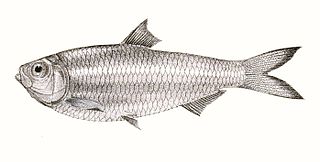 W
WThe white sardine is a species of fish in the family Clupeidae. It was described by Achille Valenciennes in 1847. It is a tropical fish of the Indo-Pacific distributed from Thailand to Indonesia and Australia. Other common names include deep herring and northern herring.